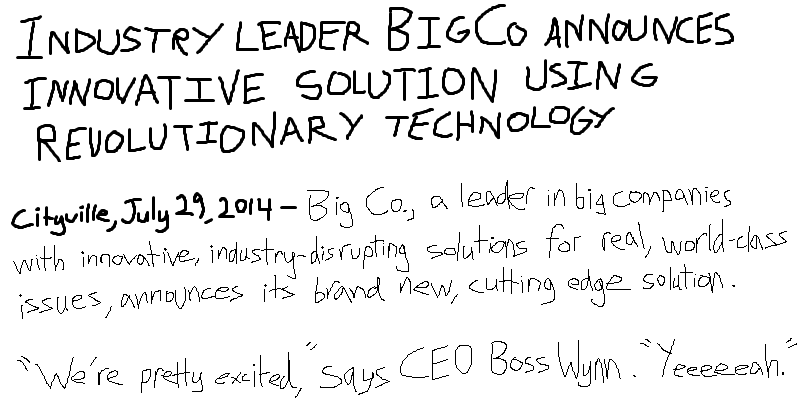10 Tips On How to Write Press Releases
At their best, press releases can strengthen your Internet presence and cultivate fresh clientele. They can put you in the good graces of journalists who can spread your news into new circles, rewarding you with viewers and fresh sets of eyes.
But they can be a landfill at their worst: A worldwide waste of space, time, and words. They can make your business and brand seem stiff, pretentious, or boring. So, how do you write press releases?
We’ve got ten tips to show you how.
1. Hook your readers.
There’s a staggering amount of content out there. How do you write press releases that get attention? It would be best if you interested readers right from the get-go. You must craft an interesting, engaging hook and promise them a benefit. And your hook needs to be in the headline and opening paragraphs.
For example, Your company is announcing a new line of refrigerators. And your press release reflects precisely that: “ColdCo Announces New Line of Refrigerators.” Readers should be excited to hear news like this, right?
Wrong. While readers may appreciate the directness of the headline, you’re missing out on the chance to offer them something more substantial. “Store Food for Years with the Cryogenic Capabilities of New Refrigerators from ColdCo.”
Which of those titles is more likely to catch readers’ interest?
2. Focus on the basics.
It’s essential to remember why you’re writing a press release in the first place: to spread your news and reach new audiences. With this in mind, ask yourself a few more questions as you’re writing your press release:
- Who are you trying to reach? Who do you want to read your press release? Are you after new clients? Are you informing current clients of a new service? Both?
- What are you offering? Is it a new product? A new service? More importantly, what problem can you help your customers solve? Be specific.
- When are you offering it? When is your service available? Concrete details are essential.
- Why are you offering it? Why would clients, potential or otherwise, want your service?
- How will you offer it? How can your press release inform and engage readers? And how will you convince them they need your service?
Ask these questions before you start writing. Answer them while you write. Then review them when you’ve finished.
3. Use meaningful words.

“Industry-leading.” “Revolutionary.” “Innovative.” These and other self-aggrandizing adjectives sound good but don’t tell readers anything useful. Press releases, like different kinds of content, are only read if they benefit their readers. Write with clarity. Use words that show readers what you will do for them and how you will do it. Write interestingly and write confidently. After all, you can write blog posts without sounding foolish. Why not do the same for your press releases?
4. Avoid technical jargon.
Nothing gunks up press releases worse than a bunch of esoteric jargon. (Editor’s note: “Esoteric gobbledygook” is a cutting-edge, dynamic term used by industry leaders that adds synergistic qualities for world-class solutions.)
Like the words in section 3 above, this jargon makes you seem brighter but at the danger of being misunderstood. And often, it doesn’t make you appear more intelligent. It might just make your readers mad, as they have been fed content like this before and too often.
To use the refrigerator analogy again: Normal readers have a better chance of finding your press release using standard search terms, such as “refrigerators for rock stars” or “best fridges for cryosleep space travel.” Don’t hurt your chances of showing up in the search results by calling your products “highly efficient mechanical units which utilize electricity for cooling and preserving food.”
5. Don’t use the first person.

Addressing the reader directly works well for blogs—less so for press releases. Remember to regard press releases more professionally. Think of press releases as more for suits and ties and blogs for shorts and sunglasses.
6. Don’t ignore SEO.
Optimizing your press releases can show your news to a broader audience.
Use keyword-rich copy and anchor text leading back to your landing pages to get ahead of the competition. Remember to be careful with your links. But don’t go overboard. Provide links in a way that readers will want to learn more. Use branded and non-branded keywords naturally. Don’t make the text read like someone awkwardly jammed a bunch of ranking keywords into the text. Not that you’d ever do that, of course.
7. Proofread your PRs.
An official business document infested with poor grammar and terrible spelling screams “unprofessional.” Is this the message you want to send as a thought leader in your industry? Your press releases should reflect your and your business’s professional nature and attitude. Plus, exemplary grammar and spelling make for more accessible, more precise reading. And that’s what creating content is all about
8. Don’t repeat yourself.
Readers—casual, journalists, and Google’s robots—prefer fresh content over rehashed material. And if they realize you’re using different words to say the same thing throughout a press release, the chances of your press release having optimal impact will decrease significantly.
Instead, use a couple of opening paragraphs to set up your press release—just enough to hook readers’ interests—and then go deeper. Use your precious paragraphs as opportunities to expand rather than fill up the word count. You only have about 400 words. Why not use them wisely?
9. Direct your focus.
Face the facts: Your press releases won’t be read by everyone. It’s a harsh fact, given that your news is more important than anything else. But acceptance is the first step towards realization.
Since your press release won’t be read by everyone, you can aim your releases toward those who will stand behind you. This will allow your press releases to catch the interest of like-minded consumers and journalists.
Back to the refrigerator example: If your new fridge features an exterior touchscreen with voice-activated controls, you probably won’t make any waves in wedding and pop culture publications. But consider targeting a technology or science magazine, and you’ll spark the interest of similar thinkers.
10. Tease your readers, but don’t cheat them.
What you have to share is essential—but don’t put everything on the table. Withhold just enough information to leave readers wanting more. If your content is good enough, your readers will eat up your press releases and seek out your website to learn more. Ensure that your press release clearly and accurately states where and how readers can find and contact your company. Following even one of these tips will have you writing press releases like a pro. Following all ten gets you closer to conversions than ever.
Find SEO Inc. on the Social sphere:
- SEO Inc Facebook
- SEO Inc Twitter
- SEO Inc LinkedIn

